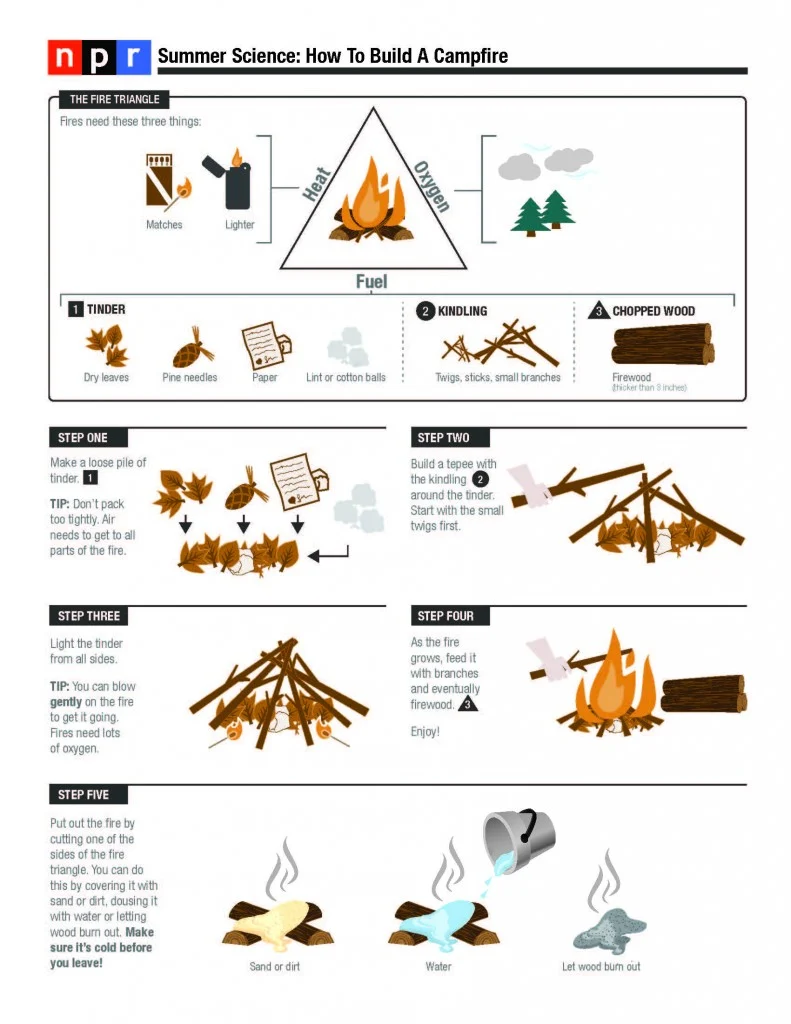
My Bear and I have been reading The Genius Files: Mission Unstoppable, and one of the main characters talks about the science behind fire. We learned that you have to have three things to have a fire: heat, oxygen and fuel. What a coincidence that I'm writing about fire today!
In the new Cub Scout program, Webelos are required to build a fire in one of their Adventures.
Webelos Adventure: Cast Iron Chef 3: Use tinder, kindling, and fuel wood to demonstrate how to build a fire in an appropriate outdoor location. If circumstances permit and there is no local restriction on fires, show how to safely light the fire, under the supervision of an adult. After allowing the fire to burn safely, safely extinguish the flames with minimal impact to the fire site.
The first step in building a campfire is to find out if you can build the campfire. Ask your campground manager if campfires are allowed. You may need a permit, so ask about that as well. Check the weather too. If your area has been hot and dry, there may be a weather restriction on fires.
Next, choose your campfire location. If the campground already has a fire pit or fire ring, use that. Otherwise, find an area that is at least fifteen feet away from tent walls, shrubs, trees or anything else that might catch on fire. Look up too. There may be low-hanging tree branches overhead.
I've read conflicting information about building fire rings out of rocks. Many people say it is important to use a fire ring to contain the fire. Others say that it's possible the rocks may split or even explode depending on the type of rock and whether or not it is holding moisture. It's also been argued that by moving the rocks, you are not “leaving no trace.” So use your best judgement about rock fire rings.
NPR's Summer Science program has an excellent infographic on the steps to take to build a fire. They showed the steps much better than I could write them! 🙂
If your Webelos follow these steps, they'll learn how to safely build a fire and complete the Cast Iron Chef requirement.
Do you have other ways of building fires?
Yours in Scouting,
Sherry
P.S. If this Webelos information was helpful, sign up below for more helpful hints!



Jessie Manckiy
Saturday 20th of January 2024
Very helpful. Thank you
How to Safely Make S'mores With Cub Scouts ~ Cub Scout Ideas
Thursday 1st of October 2020
[…] Start by building your fire safely. The Webelos handbook has great instructions for this in the Cast Iron Chef adventure. You can also learn how to build a fire with this post. […]
The Top Fire Starters You'll Want to Have During an Emergency
Sunday 15th of July 2018
[…] is struck by steel, it creates a spark to light a fire. This is kind of like when Boy Scouts learn to start a fire out of sticks and stones, but it’s much more […]
Kelly Carollo
Friday 15th of September 2017
Thank you for that great infographic. Once again, your website has helped me with my den meeting planning!
Sherry Smothermon-Short
Monday 25th of September 2017
Thanks for the kind words! I appreciate you reading the blog!
Stephen Cerruti
Tuesday 10th of February 2015
In California it has almost become normal to not light a fire. But when we do it's either above ground or in an existing fire ring.
As i understand it, lighting a fire on the ground sterilizes the ground underneath killing the microorganisms that promote a healthy ecosystem and permanently scars the landscape. Certainly leave no trace rules apply even if you can't directly see the harm being done.
It used to be that you could remove the sod and dig a hole for your fire. I'm not certain that's even a good idea any longer.
Fires are nice but should be saved for existing sites in developed areas with permission of the land manager.